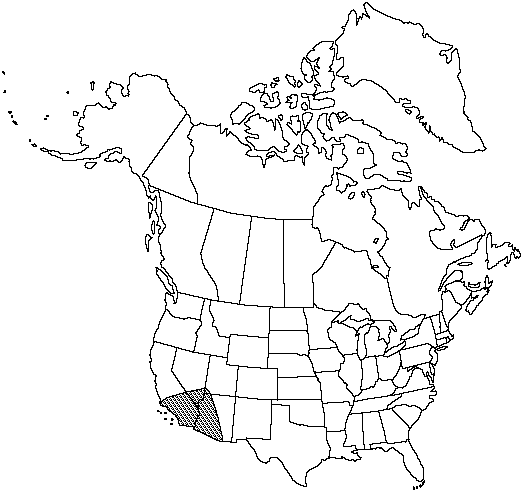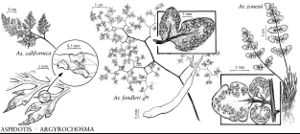Difference between revisions of "Argyrochosma jonesii"
Amer. Fern J. 77: 40. 1987.
FNA>Volume Importer |
imported>Volume Importer |
||
| (7 intermediate revisions by 2 users not shown) | |||
| Line 7: | Line 7: | ||
|year=1987 | |year=1987 | ||
}} | }} | ||
| − | |basionyms={{Treatment/ID/ | + | |special_status={{Treatment/ID/Special_status |
| + | |code=F | ||
| + | |label=Illustrated | ||
| + | }} | ||
| + | |basionyms={{Treatment/ID/Basionym | ||
|name=Notholaena jonesii | |name=Notholaena jonesii | ||
|authority=Maxon | |authority=Maxon | ||
| + | |rank=species | ||
| + | |publication_title=Amer. Fern J. | ||
| + | |publication_place=7: 108. 1917 | ||
}} | }} | ||
|synonyms={{Treatment/ID/Synonym | |synonyms={{Treatment/ID/Synonym | ||
|name=Cheilanthes jonesii | |name=Cheilanthes jonesii | ||
|authority=(Maxon) Munz | |authority=(Maxon) Munz | ||
| − | }}{{Treatment/ID/Synonym | + | |rank=species |
| + | }} {{Treatment/ID/Synonym | ||
|name=Pellaea jonesii | |name=Pellaea jonesii | ||
|authority=(Maxon) C. V. Morton | |authority=(Maxon) C. V. Morton | ||
| + | |rank=species | ||
}} | }} | ||
|hierarchy=Pteridaceae;Argyrochosma;Argyrochosma jonesii | |hierarchy=Pteridaceae;Argyrochosma;Argyrochosma jonesii | ||
| Line 25: | Line 34: | ||
}}<!-- | }}<!-- | ||
| − | --><span class="statement" id="st- | + | --><span class="statement" id="st-undefined" data-properties=""><b>Stem </b>scales brown to nearly black. <b>Leaves</b> 4–15 cm. <b>Petiole</b> dark brown, 0.75–1.5 mm diam. <b>Blade</b> ovate-lanceolate, 2–3-pinnate proximally, leathery, abaxially and adaxially glabrous; rachis rounded to slightly flattened adaxially. <b>Pinna</b> costae straight or nearly so, branches not arising from prominent angles. <b>Ultimate</b> segments not articulate, dark color of stalks continuing into segment bases abaxially; segment margins plane to slightly recurved, not concealing sporangia; veins obscure adaxially. <b>Sporangia</b> submarginal, borne on distal 1/2 of secondary veins, containing 64 spores. <b>2n</b> = 54, 108.</span><!-- |
-->{{Treatment/Body | -->{{Treatment/Body | ||
| + | |phenology=Sporulating spring–fall. | ||
|habitat=Calcareous cliffs and ledges | |habitat=Calcareous cliffs and ledges | ||
|elevation=600–1900 m | |elevation=600–1900 m | ||
|distribution=Ariz.;Calif.;Nev.;Utah;Mexico in Sonora. | |distribution=Ariz.;Calif.;Nev.;Utah;Mexico in Sonora. | ||
| − | |discussion=<p>Argyrochosma jonesii includes two sexually reproducing cytotypes. The diploid is known from a few localities in the Sonoran and Mojave Deserts; the tetraploid is found throughout the Mojave Desert and cismontane southern California. Although subtle morphologic differences exist between these cytotypes, they are distinguished primarily by characteristics known to correlate with increases in ploidy level (such as spore size and the length of stomatal guard cells). Further investigation is necessary to determine whether the tetraploid arose through autopolyploidy or hybridization between cryptic species.</p> | + | |discussion=<p><i>Argyrochosma jonesii</i> includes two sexually reproducing cytotypes. The diploid is known from a few localities in the Sonoran and Mojave Deserts; the tetraploid is found throughout the Mojave Desert and cismontane southern California. Although subtle morphologic differences exist between these cytotypes, they are distinguished primarily by characteristics known to correlate with increases in ploidy level (such as spore size and the length of stomatal guard cells). Further investigation is necessary to determine whether the tetraploid arose through autopolyploidy or hybridization between cryptic species.</p> |
|tables= | |tables= | ||
|references= | |references= | ||
| Line 40: | Line 50: | ||
-->{{#Taxon: | -->{{#Taxon: | ||
name=Argyrochosma jonesii | name=Argyrochosma jonesii | ||
| − | |||
|authority=(Maxon) Windham | |authority=(Maxon) Windham | ||
|rank=species | |rank=species | ||
| Line 47: | Line 56: | ||
|basionyms=Notholaena jonesii | |basionyms=Notholaena jonesii | ||
|family=Pteridaceae | |family=Pteridaceae | ||
| + | |phenology=Sporulating spring–fall. | ||
|habitat=Calcareous cliffs and ledges | |habitat=Calcareous cliffs and ledges | ||
|elevation=600–1900 m | |elevation=600–1900 m | ||
| Line 53: | Line 63: | ||
|publication title=Amer. Fern J. | |publication title=Amer. Fern J. | ||
|publication year=1987 | |publication year=1987 | ||
| − | |special status= | + | |special status=Illustrated |
| − | |source xml=https:// | + | |source xml=https://bitbucket.org/aafc-mbb/fna-data-curation/src/2e0870ddd59836b60bcf96646a41e87ea5a5943a/coarse_grained_fna_xml/V2/V2_294.xml |
|genus=Argyrochosma | |genus=Argyrochosma | ||
|species=Argyrochosma jonesii | |species=Argyrochosma jonesii | ||
| − | |||
| − | |||
| − | |||
| − | |||
| − | |||
| − | |||
| − | |||
| − | |||
| − | |||
| − | |||
| − | |||
| − | |||
| − | |||
| − | |||
| − | |||
| − | |||
| − | |||
| − | |||
| − | |||
| − | |||
}}<!-- | }}<!-- | ||
-->[[Category:Treatment]][[Category:Argyrochosma]] | -->[[Category:Treatment]][[Category:Argyrochosma]] | ||
Latest revision as of 20:22, 5 November 2020
Stem scales brown to nearly black. Leaves 4–15 cm. Petiole dark brown, 0.75–1.5 mm diam. Blade ovate-lanceolate, 2–3-pinnate proximally, leathery, abaxially and adaxially glabrous; rachis rounded to slightly flattened adaxially. Pinna costae straight or nearly so, branches not arising from prominent angles. Ultimate segments not articulate, dark color of stalks continuing into segment bases abaxially; segment margins plane to slightly recurved, not concealing sporangia; veins obscure adaxially. Sporangia submarginal, borne on distal 1/2 of secondary veins, containing 64 spores. 2n = 54, 108.
Phenology: Sporulating spring–fall.
Habitat: Calcareous cliffs and ledges
Elevation: 600–1900 m
Distribution

Ariz., Calif., Nev., Utah, Mexico in Sonora.
Discussion
Argyrochosma jonesii includes two sexually reproducing cytotypes. The diploid is known from a few localities in the Sonoran and Mojave Deserts; the tetraploid is found throughout the Mojave Desert and cismontane southern California. Although subtle morphologic differences exist between these cytotypes, they are distinguished primarily by characteristics known to correlate with increases in ploidy level (such as spore size and the length of stomatal guard cells). Further investigation is necessary to determine whether the tetraploid arose through autopolyploidy or hybridization between cryptic species.
Selected References
None.
